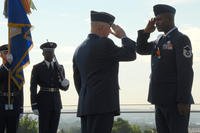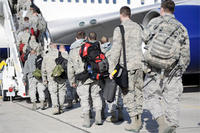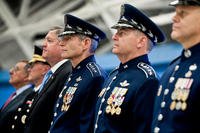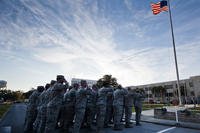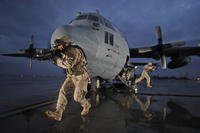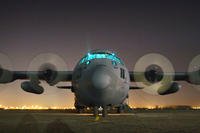The Squadron
The term "squadron" literally means a square (from the Latin quadrare, to square). In army application, squadron describes a body of troops drawn into a square or arranged in formal order. For more than four centuries, western armed forces have ordered personnel and equipment in organizations known as squadrons. In navies, a squadron was a group of vessels consisting of two or more divisions of a fleet. For armies, the cavalry squadron was the most common type and it consisted of two or more elements called troops. How air forces came to adopt the squadron is an interesting story.
Early in the twentieth century, military doctrine treated air operations as an extension of the cavalry--in effect a sky cavalry. For example, a January 1912 report to the French Chamber of Deputies argued that "the aeroplane should not replace the cavalry, even in reconnaissance work; its action should be auxiliary to that of [the cavalry] and complete it." Echoing this sentiment in 1913, Brig Gen George P. Scriven, Chief Signal Officer of the US Army, testified before Congress "the aeroplane is an adjunct to the cavalry." Even as late as 1920 a much celebrated US Army Air Service regulation seemed to reflect cavalry connections: "Pilots will not wear spurs while flying!"
When the time came to form tactical aviation organizations, most military planners simply adapted the cavalry squadron organization to their purposes. Like cavalry squadrons, the new aero squadrons were administrative and tactical units, which usually consisted of two or more elements. In England, the Royal Flying Corps formed the first two aero squadrons in May 1912. Other nations quickly followed the British example. The US Army Signal Corps organized the 1st Provisional Aero (now, 1st Reconnaissance) Squadron on 5 March 1913. The widespread adoption of the squadron model prompted Gen Henry H. (Hap) Arnold, Commanding General of the US Army Air Forces in World War II, to observe that it is "the smallest administrative organization practically universally accepted for air units."
Initially, US aero squadrons consisted of two elements called companies. By the time the United States entered World War I, they contained two or more elements called flights. Through the years, squadrons have varied in size and composition according to specific needs. However, the squadron design still endures and continues to give formal order to US Air Force assets. Air Force Instruction 38-101, "Air Force Organization," defines the squadron as "the basic unit of the Air Force." A squadron may be either a functional organization, such as a maintenance, communications, or transportation squadron, or a mission organization such as a flying, space, or missile squadron.
The Group
When the United States entered World War I in April 1917, Gen John J. Pershing, the commander of the American Expeditionary Forces soon developed a plan for the deployment of over two hundred combat squadrons to France. As these units entered combat, American airmen soon realized that they needed an intermediate organization between the squadrons and the command level. They looked to the British who had more experience in dealing with combat units and were already engaged in flying combat missions. By December 1917, after looking at British groups, the Americans decided to adopt the "group," making it the smallest self-contained tactical bombardment unit. The Americans had no expectation of bombing by squadron but by groups and perhaps combinations of groups depending on the target. By the end of 1918, the War Department had created one pursuit wing and fourteen service, fighter, bomber, or observation groups in France. After the war the US Army quickly demobilized most of its air arm, including the wing, all of the groups, and most of the squadrons. Almost immediately, however, the Army began to create new organizations for peacetime service, and the concept of the group survived, although in the 1920s and 1930s there were few groups in existence.
In January 1939 President Franklin D. Roosevelt asked Congress to strengthen America's air power, which, the President said, was "utterly inadequate." On 1 September 1939, Germany attacked Poland, beginning the Second World War. In the months that followed, as Axis forces won one victory after another, the Army's air arm expanded rapidly. By the end of 1940 there were 33 groups. Within another year, that is, by the time the Japanese attacked Pearl Harbor and the United States entered the war, the number of active groups had increased to 94. The air arm grew even more rapidly in the months following Pearl Harbor, and by the end of 1943 there were 395 groups. These groups were fighting from Europe to the Mediterranean to the far reaches of the Pacific Ocean and their contribution to winning the war cannot be underestimated. Once the victory had been gained, the United States plunged into demobilization, just as it had done at the end of the First World War. Officers and men went home. Groups inactivated, and once again a new Air Force had to be built. In 1947 the Congress created the Department of the Air Force and established the United States Air Force as a separate service equal to the Army and the Navy.
The Wing
During the Korean War, precipitated by the Communist attack on the Republic of Korea, the number of groups increased drastically. Then in June 1952 the Air Force began expressing its strength in terms of "wings" rather than "groups." It began to inactivate the combat groups and assign their combat squadrons directly to the wing.
Organizations known as "wings" have been used by the Air Force for many years. Indeed, in July 1918 the American Expeditionary Forces of the United States Army organized in France its first aircraft organization higher than a group-the 1st Pursuit Wing. Although this wing did not survive post-World War I demobilization, new wings were created in the 1920s and 1930s. During World War II numerous wings existed; some provided training in the United States, while others controlled combat groups and support organizations overseas.
Air Expeditionary Forces
On 2 August 1990, Iraqi forces invaded and overran the neighboring State of Kuwait. Five days later, American forces began deploying to the Persian Gulf area. The United States Air Force utilized "provisional" units, which are temporary, in moving personnel and aircraft to the area. These "provisional" units, along with Army, Navy, and Allied counterparts, defeated the Iraqi forces and liberated Kuwait.
Based on Air Force policy and long-standing tradition, the history, lineage, and honors of a "provisional" unit terminates when it inactivates, and battle honors earned by the "provisional" unit are not shared with the permanent unit that provided the resources. However, Central Air Force (CENTAF) with inputs from the major commands compiled a list of the regular Air Force units to earn the Gulf War campaign streamers. Air Force Military Personnel Center (AFMPC) then published the list awarding the first two campaign streamers for the Persian Gulf War.
In mid-1996, the Air Force, in response to budget cuts, major drawdowns, and changing world situations, began experimenting with air expeditionary organizations. These organizations, from squadron to wing and above, were, by definition, provisional in nature. Thus once again, in regard to air expeditionary organizations, the Air Force faced the question regarding honors earned by "provisional" units.






